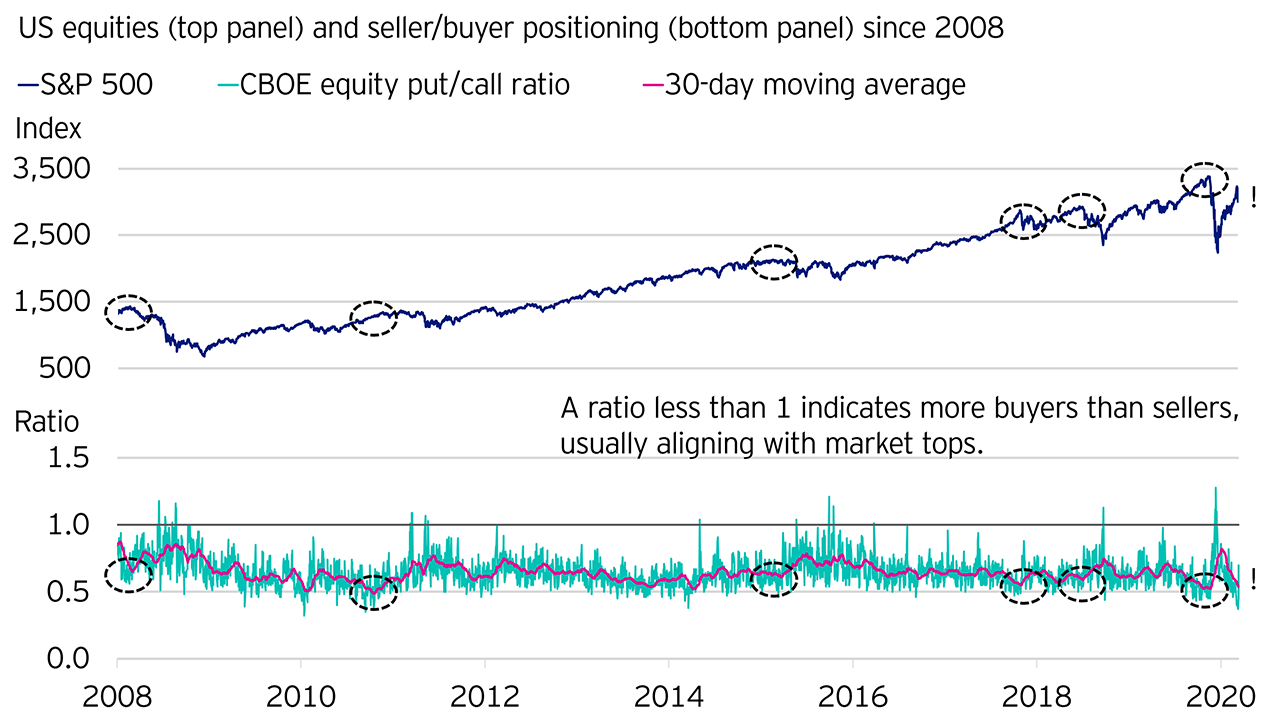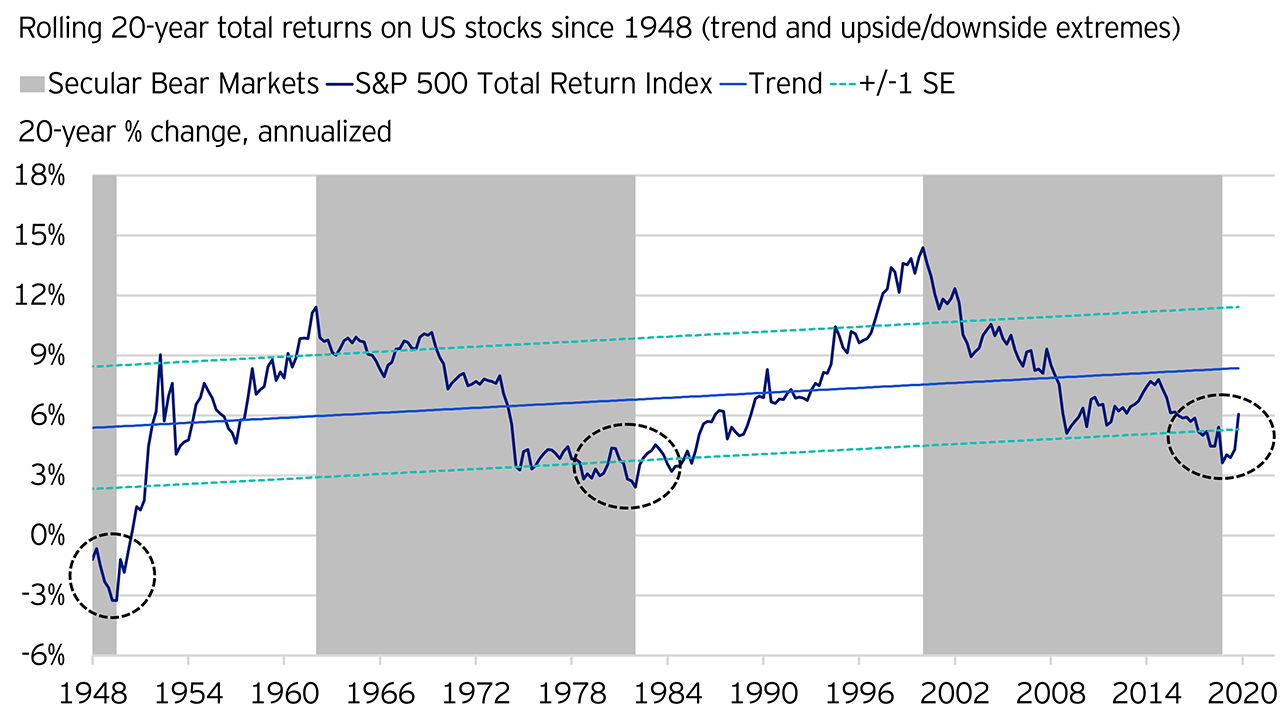Near-term pullback, long-term uptrend
Talley Léger. Investment Strategist
On March 13, 2020, we began talking1 and writing2 about a series of tactical market bottom indicators3 that showed signs of extreme risk-off positioning, which were positive from a contrarian perspective. One of those indicators was the Chicago Board Options Exchange (CBOE) equity put/call ratio. Little did we know it at the time, but ten days later, the S&P 500 Index would put in what now appears to be a major low for the cycle.
What is the CBOE equity put/call ratio and why does it matter?
The put/call ratio is a measure of seller (put) relative to buyer (call) positioning derived from the options market, where a ratio greater than 1 signals more sellers than buyers (or extremely negative investor sentiment) and usually aligns with big market bottoms. On March 12, 2020, the put/call ratio hit 1.28, its highest level since 20084—in the depths of the Great Recession and Global Financial Crisis—meaning risk-off positioning was lopsided and investor pessimism was overwhelming.
The put/call ratio served us well three months ago, but what is it telling us now?
Unfortunately, there may be at least a temporary wrinkle in the bull case for stocks. The recent trough-to-peak surge of 44% on the S&P 500 Index compressed the put/call ratio to 0.37 on June 8, 2020, its lowest level since 2010—just before the peak of the European sovereign debt crisis. In other words, risk-on positioning has gotten stretched, and the bulls are running rampant, raising the likelihood of a near-term pullback in stocks akin to what we saw in 2018, 2015 and 2011.

Beyond investor positioning, is there a broader bearish case to be made for stocks?
In our view, the bearish case includes 5 points of pessimism, namely:
1) Fears of a potentially deadly second wave of the coronavirus as the economy reopens and we approach cooler fall weather; 2) the risk of a negative feedback loop between stocks and 2Q20 gross domestic production (GDP) and earnings per share (EPS); 3) heightened US-China tensions; 4) overvaluation; and 5) tactical overbought conditions, as discussed. All valid points, any one of which could prove to be the catalyst for a near-term pullback in stocks.
Figure 2. The optimists always win in the end
| 5 Points of Pessimism (Bearish Case) | 10 Points of Optimism (Bullish Case) |
|---|---|
1. Potential second wave of the coronavirus |
1. Massive, unprecedented and coordinated monetary policy |
2. Potential negative feedback loop between stocks and GDP
|
2. Massive, unprecedented and coordinated fiscal policy |
| 3. Heightened US-China tensions | 3. Cautious investor positioning |
| 4. Overvaluation | 4. Negative investor sentiment |
| 5. Tactical overbought conditions | 5. Structural oversold conditions |
| 6. Plateauing or flattening coronavirus daily cases | |
| 7. Potential treatment for the disease | |
| 8. Potential vaccine for the virus | |
| 9. High-frequency economic data are improving | |
| 10. Economy is reopening |
Source: Invesco, 11/06/20. Notes: GDP = Gross domestic production. EPS = Earnings per share.
How does the bullish case stack up?
That said, we remain compelled by the breadth and scope of the bullish case, which includes the following 10 points of optimism:
1) Massive, unprecedented and coordinated monetary policy support; 2) similarly impressive fiscal policy support; 3) cautious investor positioning in the form of high cash balances and net short positions in stocks; 4) negative investor sentiment as expressed by persistent outflows from stocks and more bears than bulls in the individual investor survey; 5) a structural oversold condition as seen in the rolling 20-year total returns on stocks; 6) plateauing or flattening coronavirus daily cases overall; 7) a potential treatment for the disease that is being researched and developed by a host of companies around the world, and that has already moved to human trials; 8) a potential vaccine for the virus that is evolving similarly; 9) the high-frequency economic data like weekly initial claims for unemployment insurance are improving; and 10) the economy is reopening and activity is moving in the right direction, as evidenced by the daily mobility data.
Is this a cyclical bear market in a secular bull market, or is this a cyclical bull market in a secular bear market?
While it may seem like a daunting task, we believe it is possible to differentiate between secular bull and bear markets. It is said that the trend is your friend except at the end where it bends. Historically, secular bull markets have not ended until stocks have produced 20-year annualized total returns of 11% to 15%. In the current environment, however, 20-year returns remain muted, so much so in fact that they seem more consistent with a secular bull market in its earlier stages than one in its later stages.

Amidst the biggest economic event in modern history, we must admit to being surprised by the v-shaped stock market recovery and the fact that equities haven’t yet re-tested the March low. Based on some of the tactical breadth and positioning indicators that we monitor, however, there is a case to be made for a near-term pullback in stocks. Short-term volatility aside, we believe the long-term bull case (10 points of optimism) outweighs the bear case (5 points of pessimism). As such, we think investors may benefit from maintaining structural exposure to stocks in the years ahead.
Related insights: Read more from Kristina Hooper about our global and regional base cases for the recovery with contributions from our regional investment strategists.
Listen to our new podcast where Kristina Hooper and Ben Gutteridge discuss all major talking points investors are currently grappling with.
Footnotes
-
1 Source: BNN Bloomberg, Why this strategist sees long-term investment opportunities post-Covid 19 chaos, 13/03/20.
2 Source: Invesco, Chaos can create opportunities, 19/03/20.
3 Source: Invesco, Looking for signs of a bottom in stocks, 01/04/20.
4 Source: Bloomberg L.P. as of 31/05/2020
Investment risks
-
The value of investments and any income will fluctuate (this may partly be the result of exchange rate fluctuations) and investors may not get back the full amount invested
Important information
-
Data as at 12.06.2020, unless otherwise stated. This document is marketing material and is not intended as a recommendation to invest in any particular asset class, security or strategy. Regulatory requirements that require impartiality of investment/investment strategy recommendations are therefore not applicable nor are any prohibitions to trade before publication. The information provided is for illustrative purposes only, it should not be relied upon as recommendations to buy or sell securities.
Where individuals or the business have expressed opinions, they are based on current market conditions, they may differ from those of other investment professionals, they are subject to change without notice and are not to be construed as investment advice.
Contrarian investing is an investment style in which investors purposefully go against prevailing market trends by selling when others are buying, and buying when most investors are selling.
A put option is an instrument that gives the holder the right to sell an asset, at a specified price, by a specified date to the writer of the put.
A call option is an instrument that gives the holder the right to buy an asset, at a specified price, by a specified date from the writer of the call.
GDP is the total value of all finished goods and services produced within the United States’ borders in a specific time period.
EPS are the total value of US corporate profits divided by the same companies’ common stock outstanding.
The SE is a statistical term that measures the accuracy with which a sample distribution represents a population by using standard deviation.

